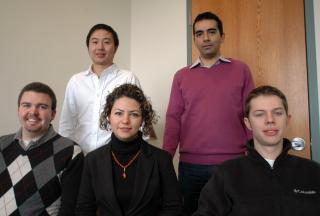
SNR’s graduate students Anthony L. Nguy-Robertson, Tarlan Razzaghi, and David Gibbs and UNL electrical engineering’s graduate students Salman Kahrobaee and Dingguo Lu took fifth place in the international IBM/IEEE 2012 Smarter Planet Challenge for their project “GIS-Based Wind Farm Suitability and Planning Study.”
The project sought to discern the most suitable location in New Hampshire to host a wind farm. Taking into account populated areas, developed areas, natural habitats, and existing infrastructure, the GIS model looked for potential wind farms that would yield 400-800 watts/m2. Engineering students Kahrobaee and Lu then conducted a cost and equipment analysis to determine the most efficient and cost effective location for harnessing wind energy.
“Our part in the project particularly focused on suitability analysis,” Razzaghi said. “We layered data to find the place that would be the best location for a wind farm.”
“Topographical considerations like land cover, wetlands, and distance from existing transmission lines were important parts of our examination,” Nguy-Robertson said, “as well as avoiding national parks and forests.”
“And buffering for rivers and airports,” added Razzaghi.
The team worked in conjunction with SNR’s Don Rundquist and UNL electrical engineering professor and chair Jerry Hudgins. “These students deserve a lot of credit for undertaking the project in the first place, as it meant a considerable amount of extra work,” said Rundquist. “They are a talented, energetic group.”
The IBM/IEEE Smarter Planet Award evaluated projects according to their relevance to real world problems, the clarity and significance of the engineering and conceptual principles, whether the projects permitted alternative solution methods, and to what degree the projects could be replicated in other areas.
“I could see someone using our project as a guideline for proposing a wind farm,” said Gibbs. “We have a standard operation for collecting ‘free’ GIS data layers, creating parameters for a GIS model, knowledge of certain wind turbines, and a decent budget plan.”
“I think we created a nice bridge between engineering and geography,” Gibbs added.
IBM/IEEE recommended that teams include at least one member of a field other than engineering. Nguy-Robertson, Razzaghi, and Gibbs all cited the partnership between GIS/Geography and electrical engineering as a factor in their project’s success.
“Collaborations are really key in our field,” Nguy-Robertson said.
Razzaghi agreed. “Probably the greatest contributing factor to our success was the fact that we incorporated another perspective.”
The team received $1000 to fund the advancement of their research.